|

SHISHI LIONS
SHRINE & TEMPLE GUARDIANS
WITH MAGICAL POWERS TO REPEL EVIL
Jp. = Shishi 獅子 or Kara Shishi 唐獅子, Chn. = Shíshī
Also known as Koma-inu 狛犬 (lion dog) in Japan
Origin = China & Korea
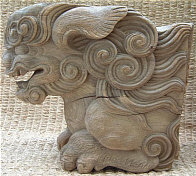 
Wooden shishi carvings are commonly used as architectural elements, placed under
the eaves of both Shinto shrines and Buddhist temples to ward off evil spirits.
Also, a pair of stone shishi statues (one with mouth open, the other closed)
typically stand guard outside the entrance to Shinto shrines.
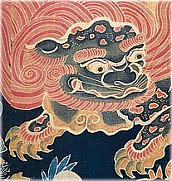 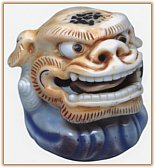
Shishi likewise appear frequently in paintings, netsuke, & other art forms.
(L) Modern Painting (R) Saikumono - Hirado porcelain
Shishi (or Jishi) is translated as "lion” but it can also refer to a deer or dog with magical properties and the power to repel evil spirits. A pair of shishi traditionally stand guard outside the gates of Japanese Shinto shrines and Buddhist temples, although temples are more often guarded by two Nio Protectors. The Shishi (like the Nio) are traditionally depicted in pairs, one with mouth open and one with mouth shut. The opened/closed mouth relates to Ah (open mouth) and Un (closed mouth). “Ah" is the first sound in the Japanese alphabet, while "N" (pronounced "un") is the last. These two sounds symbolize beginning and end, birth and death, and all possible outcomes (from alpha to omega) in the cosmic dance of existence. The first letter in Sanskrit is "Ah" as well, but the last is "Ha." Nonetheless, the first and last sounds produced by the mouth are "Ah" and "M." The Sanskrit "m" and the Japanese "n" sound exactly the same when hummed with mouth closed. The spiritual Sanskrit terms AHAM and AUM thus encapsulate the first letter-sound (mouth open) and the final sound (mouth closed). Others say the open mouth is to scare off demons, and the closed mouth to shelter and keep in the good spirits. The circular object often shown beneath their feet is the Tama 玉, or sacred Buddhist jewel, a symbol of Buddhist wisdom that brings light to darkness and holds the power to grant wishes.
IMPORTANT TERMS
- Koma-inu 狛犬 (Korean dog). The close-mouthed beast, sometimes with a horn atop its head, is often translated as lion-dog. It is typically placed to the right of the shrine or temple gate. The name is derived from Koma 高麗, the Japanese term for the old Korean kingdom of Koguryo 高句麗. For reasons unknown (to me), the horn disappeared long ago, and rarely appears in artwork of the Edo-period onward. Today the term koma-inu (komainu) is commonly used to refer to both the closed-mouthed and opened-mouthed statues.
- Kara-shishi 唐獅子 (Chinese lion). The open-mouth beast resembling a lion; translated simply as lion. It is typically placed to the left of the shrine or temple gate. Kara 唐 is another reading for Tang 唐 (as in China’s Tang Dynasty). It is meant to suggest something of Chinese or foreign import.
- Shishi 獅子. Another term for Kara-shishi 唐獅子 (Chinese lion). Today the term shishi is commonly used to refer to both the closed-mouthed and opened-mouthed statues.
KOMA-INU 狛犬 and KARA-SHISHI 唐獅子
This mythical beast was probably introduced to Japan from China via Korean in the 7th or 8th century AD, during the same period as Buddhism’s transmission to Japan, for the Japanese shishi combines elements of both the Korean "Koma-inu" (Korean dog) and Chinese "Kara-shishi" (Chinese lion). One prominent theory holds that the shishi derives from the Chinese Foo Dog (see LEARM MORE below for more). Lions, by the way, are not indigenous to Japan, China or Korea, and supposedly entered those nations in the form of imported art and sculpture, with the earliest traces of the animal appearing in China’s Han Dynasty (about 208 BC to 221 AD).
Says JAANUS: KOMAINU 狛犬. “Literally 'Korean dog.' A pair of lion-like guardian figures placed at each side of a shrine or temple entrance; believed to ward off evil spirits. Thought to have been brought to Japan from China via Korea, their name is derived from Koma 高麗, the Japanese term for the Korean kingdom of Koguryo 高句麗. In the early Heian period (9c) the two statues were clearly distinguished: the figure on the left, called shishi 獅子 (lion), resembled a lion with its mouth open (agyou 阿形); the figure on the right, called komainu 狛犬 (Korean dog), resembled a dog with its mouth closed (ungyou 吽形), and sometimes had a horn on its head. Gradually the term komainu came to be used for both statues, and their shapes became indistinguishable except for the open and closed mouths (a-un 阿吽). In the Heian period (9-12c) komainu were used as weights or doorstops for curtains and screens in the Seiryouden 清涼殿, Kyoto Gosho 京都御所. Other famous examples include a pair of painted wooden komainu (10-11c) at Yakushiji 薬師寺, Nara; 14 painted and lacquered wooden figures at Itsukushima Jinja 厳島神社, (12-14c) Hiroshima prefecture, and the stone figures inside the south gate of Toudaiji 東大寺, Nara, made by the 12c Chinese sculptor Chinnakei 陳和卿.” <end JAANUS quote>

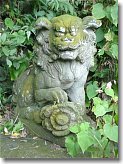 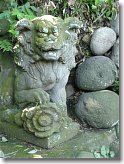 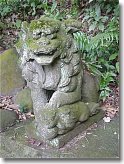
Stone statues from Meiji Period (private home in Kamakura)
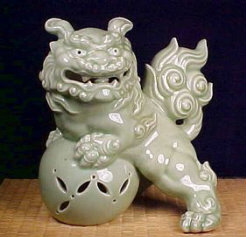
CELADON SHISHI
courtesy www.fareastasianart.com
The open mouth, along with the pierced ball, indicate a male shishi,
representing the Yang, male, and active principle of the universe

In China, the lion is the master of all felines, the defender of law, and the protector of sacred buildings. It is a symbol of power and success, and of royality and strenghth. Images of it were embroidered on court robes. In Korea, the skin on Koma-inu’s head was believed to be stronger than a helmet. In Japan, the shishi is a noble beast who protects the entrace to the temple/shrine, and in some cases, the tomb. Shishi nearly always come in mated pairs (male and female). Helena Burton at Oxford University says the shishi is sometimes tattooed on a woman's belly to protect her during childbirth. Occasionally, Buddhist deities are depicted mounted on the beast, in particular Monju Bosatsu.
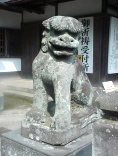 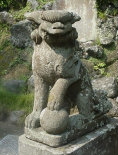
Stone Guardians Outside Hansobo Shrine in Kamakura
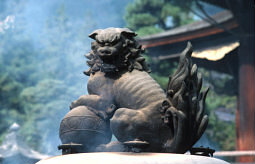
Koma-inu at Zenkoji in Nagano
From the wonderful photo library of Angus McIntyre

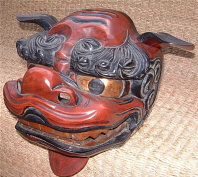  Local Myth, The Lion Dance Local Myth, The Lion Dance
In Japan, the shishi-mai or lion dance is often seen at shrine festivals and at New Year's, when performers visit each home in the neighborhood to cast charms against evil spirits and diseases while receiving offerings. A shishi-gashira, or lion’s head, is the headdress worn by the performers. The shishi-gashira, moreover, is traditionally placed near a newborn baby boy because the lion's magic is believed to protect the boy from evil spirits and misfortune. Today there are still many skilled craftsmen making shishi-gashira.
Shishi-mai, or "Lion Dance," is performed while wearing the headdress or various masks. Shishi masks take on many forms, some with horns, others looking like a dog, a deer, or a lion. This dance was probably introduced to Japan by or before the 8th century owing to frequent Japanese missions to China’s Tang Court during the 7th-8th centuries AD. Shishi-mai dances became widespread in Japan thereafter as both a form of festival entertainment and as a means to ward off evil spirits, to pray for peace, bountiful harvests, and good health. The Wharton (Tokyo) web site reports that over 9,000 different Shishi-mai dance forms are still performed throughout Japan.
SHISHI NOH MASKS
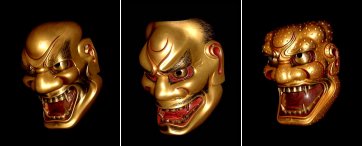
- Left - Shishi-guchi (lion's mouth) mask, used for the lion spirit in Scene II of Shakkyo (play from which many Kabuki lion dances are derived)
- Center. Ko-jishi (ko-shishi) mask used in Noh plays
- Right. O-jishi. Mask used to depict the parent of Ko-jishi. This mask is used for two or more lions in a scene of the play

Open Mouth, Closed Mouth
According to the Kyoto National Museum, the open-mouth animal is just a lion. Only the close-mouth animal is a lion-dog. The museum also says that early artwork of the shishi depicted one with a horn on its head (as found at Toji Temple 東寺 in Kyoto), but by the Kamakura Era, the horned beast of earlier times had been replaced by the hornless version.
The practice of pairing one lion-dog with one lion, says the museum, started in the Heian Period (794-1185). Before that, during the Nara Period, the pair had always consisted of just two lions. Click here for full story from the Kyoto National Museum.
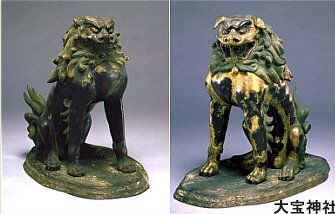
Koma-inu. Photo courtesy Kyoto National Museum.

Koma-inu. Photo courtesy Kyoto National Museum.
Says the museum: “One has its mouth open, the other closed.
The one with closed mouth has a horn on its forehead.
This is a very important point, for the open-mouthed beast
is not a lion-dog, but just a lion! Only the close-mouthed
lion-dog with the horn is really a lion-dog.”

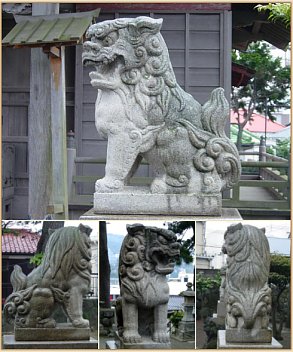
Stone Shishi at Zenyo-in (Inatori City)
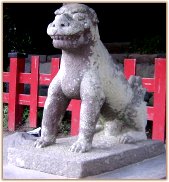 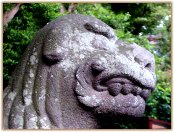 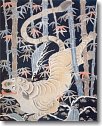
Left & Middle: Koma-inu 狛犬 at Tsurugaoka Hachimangu Shrine (Kamakura)
Right: Modern Shishi painting (photo from www.tsutsugaki.org)
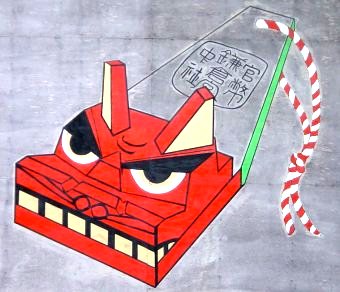
Shishi Noise Maker from Kamakura-gu Shrine (Daitonomiya) in Kamakura
Holding this toy by the handle (see green line above), you shake it up and down.
The head and mouth, which are separate pieces, make the sharp sound of wood on wood

MORE PHOTOS HERE

LEARN MORE
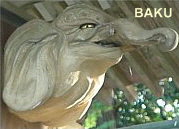 RELATED ARTWORK. Like images of the shishi, effigies of Baku 獏 (a mythological Chinese creature thought to devour nightmares) are commonly placed under the eaves of Japanese Buddhist temples and Shinto shrines to ward off evil spirits. Images of the dragon are also found frequently as decorative architectural elements at religious sites. Baku rose to popularity in Japan’s Edo period (1603 to 1868). RELATED ARTWORK. Like images of the shishi, effigies of Baku 獏 (a mythological Chinese creature thought to devour nightmares) are commonly placed under the eaves of Japanese Buddhist temples and Shinto shrines to ward off evil spirits. Images of the dragon are also found frequently as decorative architectural elements at religious sites. Baku rose to popularity in Japan’s Edo period (1603 to 1868).
|